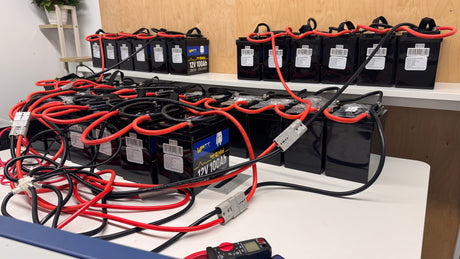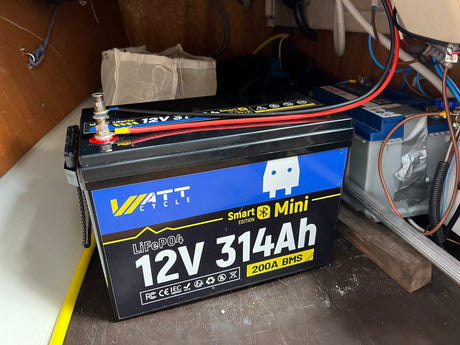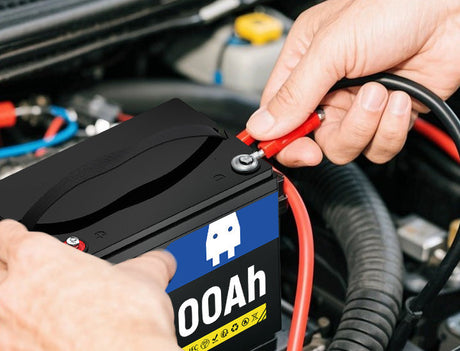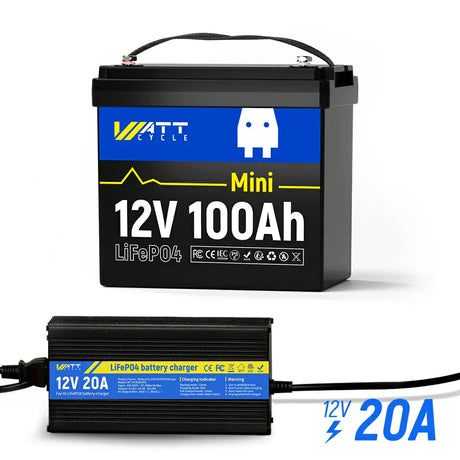Proper storage of LiFePO4 batteries is crucial for maintaining their performance and longevity, especially during periods of non-use. Whether you're storing your battery for a few weeks or several months, ensuring it’s kept in the right conditions can make a significant difference in how well it functions when you need it most.
This article will guide you through the best practices for storing your LiFePO4 batteries during periods of non-use, focusing on temperature, charge levels, and other key factors to ensure your battery stays in optimal condition until you’re ready to use it again.
Why Proper Storage Matters
LiFePO4 lithium batteries stand out from other battery types due to their unique chemistry, which offers numerous benefits, such as increased safety, longer lifespan, and higher energy density. Unlike traditional deep cycle batteries, such as AGM batteries, LiFePO4 batteries have a more stable structure and are less prone to overheating or leaking, making them a safer choice for long-term use. However, they are still sensitive to storage conditions, and improper handling can lead to decreased performance or even damage.
When it comes to storing your LiFePO4 lithium battery, keeping it in the right conditions is essential. If the battery is stored in an environment that is too hot, too cold, or overcharged/undercharged, it can lead to irreversible damage. For example, storing a LiFePO4 battery in high temperatures can accelerate the chemical reactions inside the battery, reducing its capacity and overall deep cycle lithium battery lifespan. On the other hand, if stored in freezing conditions, the battery may experience a drop in voltage or become permanently damaged.
Inadequate charge levels during storage are another common issue. Storing a deep cycle battery that is either fully discharged or fully charged can also affect its ability to retain charge over time. Ensuring that the battery is stored at an optimal charge level is key to maintaining its performance when you’re ready to use it again.
Ideal Temperature for Storing LiFePO4 Batteries
When it comes to storing your 12V LiFePO4 batteries, temperature plays a crucial role in maintaining their health and performance. For optimal storage, it is recommended to keep LiFePO4 batteries in a temperature range between 32°F (0°C) and 77°F (25°C). This range ensures that the battery’s internal components are not exposed to excessive stress, allowing it to retain its capacity and functionality over time.
While most lithium batteries are sensitive to extreme temperatures, WattCycle LiFePO4 batteries offer a unique advantage. Thanks to their Low Temperature Protection, they can operate efficiently in conditions as low as -4℉ (-20℃) and as high as 158℉ (70℃). This feature makes WattCycle LiFePO4 lithium batteries highly adaptable to various climates, whether you’re in colder northern regions or experiencing intense heat in desert areas.

However, even with this robust temperature range, it is still best to store your deep cycle LiFePO4 battery within the recommended range of 32°F (0°C) to 77°F (25°C) when not in use. Storing your battery in temperatures outside of this range for extended periods can still lead to reduced capacity or efficiency when it’s time to use it again.
- Too Hot: Storing a 12V LiFePO4 battery in temperatures higher than 158℉ (70℃) can lead to the battery's internal chemistry breaking down, decreasing its lifespan and performance. While the WattCycle LiFePO4 battery can handle heat better than most, prolonged exposure to extreme heat can still cause permanent damage.
- Too Cold: In freezing conditions below -4℉ (-20℃), while the WattCycle battery can still function, it’s best to avoid such extremes during storage. Cold temperatures can lead to reduced voltage and poor performance, and if not managed, can cause long-term damage.
By keeping your LiFePO4 battery within the ideal storage temperature range and taking advantage of WattCycle’s temperature resilience, you help ensure that your battery remains in top condition, no matter the climate.
Charge Level Considerations for Storage
Properly charging your deep cycle LiFePO4 battery before storage is crucial to maintaining its longevity and performance. Storing a LiFePO4 lithium battery at the wrong charge level can lead to battery degradation, reduced capacity, and overall shorter lifespan.
Before storing your LiFePO4 battery, it's essential to ensure it is neither overcharged nor overly discharged. LiFePO4 batteries function best when stored at an optimal charge level, typically around 50% to 60% of their full capacity. This charge level strikes the right balance, helping to prevent both chemical degradation and excessive voltage drop, ensuring that the battery is ready for use when you need it.
Avoid Overcharging: Storing your 12V deep cycle battery at 100% charge for long periods can cause internal chemical reactions to occur more quickly, leading to a loss in capacity and battery life. While WattCycle LiFePO4 batteries are designed to handle a wide range of conditions, consistently overcharging a battery before storage can still lead to premature wear.
Avoid Deep Discharge: Similarly, storing a deep cycle battery that is fully discharged can cause irreversible damage. LiFePO4 batteries are designed to maintain performance over many charge cycles, but letting the charge drop too low while in storage can lead to voltage instability and may cause the battery to fail to charge properly upon reactivation.

To ensure your LiFePO4 lithium battery stays in top shape during storage, aim to charge it to around 50% to 80% before storing it. If you plan to store it for an extended period, it’s a good idea to check the charge level every few months and top it off if necessary to keep it within that ideal range.
Storage Environment: Protecting from the Elements
When storing your LiFePO4 lithium battery, protecting it from environmental elements is just as important as controlling temperature and charge levels. A proper storage environment ensures that your 12V LiFePO4 battery remains in optimal condition, free from factors that could compromise its performance and lifespan.
Storing your battery in a dry, ventilated space is essential. Humidity and moisture are some of the most damaging factors for batteries, as they can lead to corrosion of internal components. Exposure to moisture can cause short circuits or even permanently damage the battery, so it’s critical to keep your deep cycle LiFePO4 battery in a space that is both dry and well-ventilated. Avoid storing your battery in areas prone to dampness, such as basements or sheds, as these environments can accelerate battery wear.
Likewise, direct sunlight should be avoided during storage. While WattCycle LiFePO4 batteries are engineered to withstand extreme temperatures, prolonged exposure to direct sunlight can cause the battery to overheat, leading to a decrease in efficiency and capacity over time. A cool, shaded area, away from direct sunlight, is the best place to store your 12V LiFePO4 battery.
In addition to humidity and sunlight, it’s important to keep the battery away from any sources of chemicals or flammable materials. These elements can also negatively affect the battery’s health, compromising safety and performance.
By ensuring that your LiFePO4 lithium battery is stored in a dry, ventilated, and temperature-controlled environment, you can greatly extend its life and maintain its efficiency for years to come.
Regular Maintenance During Storage
Even when not in use, your LiFePO4 battery requires occasional attention to ensure it stays in peak condition. Regular maintenance during storage is key to preventing degradation and ensuring that your deep cycle LiFePO4 battery is ready for use when you need it. Here are some simple guidelines to follow:
Check on Your Battery Every Few Months: It’s a good idea to inspect your deep cycle LiFePO4 battery every 3 to 6 months, even when it’s in storage. Start by checking the charge level—ideally, it should be around 50% to 60%. If the charge has dropped below 40%, it’s time to recharge the battery to prevent potential damage from deep discharge. Over time, even without use, some batteries naturally lose charge, so a quick check can prevent this issue. However, WattCycle LiFePO4 Static discharge rate is less than 3% per month, other batteries lose 5% of their charge per month, even if you are not using it.
Recharging When Needed: If the charge level drops below the optimal storage range, recharging the LiFePO4 lithium battery is essential to maintain its performance. Ensure that you use a charger that is compatible with your LiFePO4 batteries, note that the voltage of the charger should match that of your battery. As using the incompatible charger could damage the battery. When recharging, avoid charging the battery to 100% unless you plan to use it immediately—keeping it between 50% and 80% is the best way to maintain long-term health.
Clean the Terminals: While checking on the battery, take a moment to inspect the terminals for any signs of corrosion. Even though LiFePO4 batteries are designed to be more resistant to corrosion than other types of batteries, it’s still a good practice to clean the terminals if you notice any buildup. Use a soft cloth and, a mixture of baking soda and water to gently clean the terminals. Dry them thoroughly afterward. Learn more maintenance tips please click here.
By following these simple maintenance steps every few months, you can help extend the life of your LiFePO4 lithium battery and ensure it remains in optimal condition for whenever you need it next.
At WattCycle, we stand by our commitment to providing durable and reliable deep cycle battery solutions designed to meet the demands of everyday use. Our robust LiFePO4 battery is engineered to perform efficiently in a variety of conditions, ensuring that you receive a trustworthy energy storage solution every time.
Visit WattCycle today to explore our range of 12V LiFePO4 batteries, now available at special promotional prices, and discover how our products can support your energy needs with confidence and reliability.









